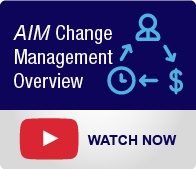Over more than two decades of change management consulting, we have had the opportunity to observe what works well in implementation—and where the traps are that get in the way of project success. It’s a long-term field-research opportunity, and includes data from leading global organizations. Here’s what the research from our change management consulting tells us are 7 of the most common “bumps in the road” that cause projects to de-rail. 
1. The organization lacks a rigorous project management system and discipline. We have talked about the importance of governance, a key element of project management. If the organization is investing in enterprise-wide change, or any type of complex change, it goes without saying that professional project management is essential.
2. There is no status-reporting mechanism. One of the major benefits of the Accelerating Implementation Methodology (AIM) is that it serves as a risk-dashboard for your change. By employing the measurement diagnostics such as the Risk Forecast at milestones throughout the project, you can identify where risks are emerging that need to be addressed. Again, it’s important that status-reporting include progress and risks across all 5 measurement dimensions: time, budget, business objectives, technical objectives, and human objectives.
3. Low accountability or risk-averse culture or implementation history exists. Who exactly is accountable for the success of your project? Is it just the project team? What about your reinforcing sponsors—do they have any accountability? (We know that you can expect the most resistance from mid- to upper-level managers.) And if you have identified that your organization has a risk-averse culture, how are you changing the reinforcements so that it becomes politically safe to drive innovation?
4. Agents and sponsors are seduced by activity or the “plan.” Simply put, your project team can be very busy, but are you busy doing the right things? Change is dynamic, and you must constantly have your fingers on the pulse of where resistance is emerging and whether you are getting what you need from sponsors. You can’t be so locked into the plan that you are not adapting to current developments.
5. Fire-fighting “arsonists” are rewarded. One of the common problems we see in our change management consulting is that by rewarding the individuals who fix the crises, the organization is actually encouraging the crises themselves. It becomes a self-replicating behavior. This is why creating a “burning platform” for change doesn’t work! You encourage the fires!
6. Agents are seduced by actions that are “safe” but have low impact. The pace of your project is based on sponsor drive, not on the level of project activity from the project team. So it stands to reason that if your team isn’t focused on securing active sponsorship, creating reinforcement, and you are avoiding dealing with resistance you may not be focused on the “right stuff.”
7. Scarce resources aren’t targeted by measurement for maximum impact. Since you will never have all the resources you need for implementation, the key is to target those resources in the places where you will get the greatest impact. You can’t do that without measurement—that’s why the AIM measurement diagnostic tools are so useful. Remember, the more often you measure, followed by positive and negative reinforcements, the faster you can go.
Do you see these barriers in your organization? What are you doing about it?


